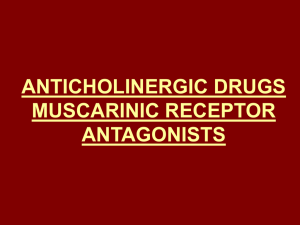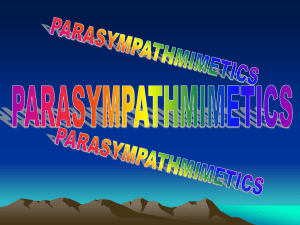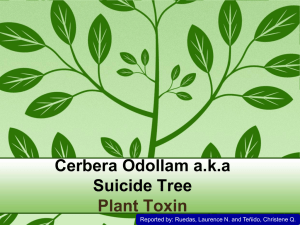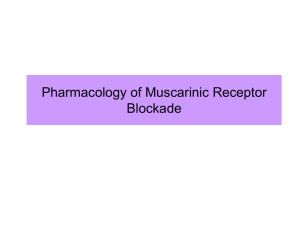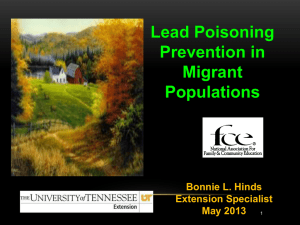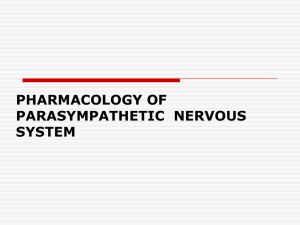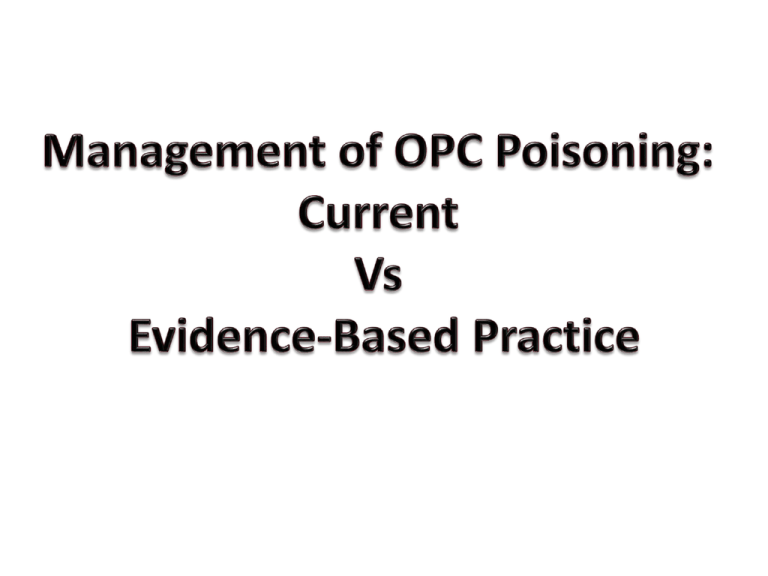
Background
DiseasesNeither Preventable Nor Curable. e.g., MS
Preventable but Not Curable e.g., Lung cancer
Preventable and Curable e.g. OPC poisoning
• More than 200 000 deaths each year in
developing countries
• Mortality from severe poisoning is high (>10%)
BMJ 2007;334:629-34
Acetylcholinesterase (AChE)
AChE is an enzyme that degrades the neurotransmitter acetylcholine
AChE
↗
Mechanism of toxicity of
organophosphorus
compounds
Mechanism of toxicity of organophosphorus compounds
Some OP available in Bangladesh
Dimethyl compounds ( ageing 3.7 hours)
• Malathion
• Dichlorvos
• Dimethoat
• Fenthion
Diethyl compounds ( 31 hrs)
• Chlorpyrifos
• Diazinon
• Parathion
• Quinalphos
Pathogenesis
Inhibition of acetyl cholinesterase leads to the accumulation of
acetylcholine at cholinergic synapses, interfering with normal
function of the autonomic, somatic, and central nervous systems.
This produces a range of clinical manifestations, known as the acute
cholinergic crisis
O
P
C
C
N
S
N
I
C
Ach
M
U
S
Atropine
Acetyl Cholinesterase
O
X
I
M
E
S
Breakdown
products
Signs and symptoms of OPC poisoning
Four clinical syndromes have been described:
1. Acute cholinergic syndrome (most common)
2. Sub acute proximal weakness (Intermediate
syndrome)
3. Organophosphate induced delayed neuropathy
(OPIDN)
4. Chronic organophosphate induced neuropsychiatric
disorder (COPIND)
Grading of severity of poisoning
• Clinical Grading
• Biochemical Grading
Grading of severity of poisoning
Clinical grading: based on1.Miosis
2.Fasciculation
3.Respiratory Rate
4.Bradycardia
5.Level of consciousness
*Mild(0-3), * Moderate(4-7), *Severe(8-11)
Grading of severity of poisoning
Biochemical Grading:
Red cell cholinesterase activity (% normal)
• 20-50%
• 10-20%
• <10%
Grade
Mild
Moderate
Severe
Management of OPC Poisoning
Hospitalization/ ICU
1. Initial stabilization
2. Reduction of exposure
3. Administration of specific antidote
4. Supportive treatment
Initial Stabilization of the patient
• Clear airway and
• Adequate ventilation because the patient with
acute organophosphate poisoning (ACC)
commonly presents with respiratory distress.
• Oxygen- high flow
?? Prior to atropinization
• Circulation- iv access
Decontamination
• Dermal spills—wash pesticide spills from the patient
with soap and water and remove and discard contaminated clothes,
shoes and any other material made from leather
• Gastric lavage—consider for presentations within 1 or 2 hours, when
the airway is protected. A single aspiration of the gastric contents
may be as useful as lavage
• Activated charcoal without cathartic—50 g may be given orally or
nasogastrically to patients who are cooperative or intubated,
particularly if they are admitted within
one or two hours or have sever toxicity
Investigations
ECG: torsades de pointes
Oxygen saturation
Blood gas analysis
Renal and hepatic function
Electrolytes
Glucose
Amylase
Antidotes in the treatment of OPC poisoning
• Atropine- Reverses the muscarinic features.
• Oxime- Reactivate cholinesterase and
reverses the nicotinic features.
Dosage regimens of Atropine
• Repeated doses of atropine should be
administered until signs of atropinisation
appear.
• Conventional Vs Evidence-Based Practice
• Try test dose of atropine
Dosage regimens of Atropine
Test dose of Atropine:
It is preferable to initiate the antidote therapy with
a 'test dose' of parenteral atropine-sulphate (1.2 mg
in adults and 0.01 mg/kg in children IV)
This therapeutic test provides a measure of severity
of organophosphate poisoning.
If the signs of atropinisation occur rapidly, it is
unlikely that the poisoning is severe or it may not be
OPC poisoning.
Dosage regimens of Atropine:
Conventional Practice
• Dosage regimens are usually designed according to the
severity of poisoning and to the signs of atropinisation
• 2-5 mg every 5-10-15 minutes. After initial
atropinization, maintain the atropinization by reducing
the dose or increasing the duration between doses of
atropine
• 1 ampoule contains 0.6 mg atropine sulphate
Dosage regimens of Atropine: Alternative
regimen: ??? Evidence-Based
• Give first dose atropine immediately
1.8–3 mg (three to five 0.6 mg ampoules)
rapidly IV into a fast-flowing IV drip
• Don’t delay starting atropine if oxygen is unavailable
BMJ 2007;334:629-34, J Med Toxicol 2012 Feb17 online
Assess – is the patient atropinised?
After 3-5 minutes of atropine administration
record followings :(1) air entry into lungs: clear chest
(2) blood pressure: SBP > 80 mm Hg
(3) heart rate: > 80 beats/ min
(4) Pupil: no longer pinpoint
(5) Dry axillae
Contd.
Assess – is the patient atropinised?
• Mark them on an OPC observation sheet
• A uniform improvement in most of the five parameters
is required, not improvements in just one.
• Pupil dilatation is sometimes delayed. and the other
parameters may improve more rapidly, it is reasonable
to observe air entry on chest auscultation, heart rate,
and blood pressure as the main parameters for
adequate atropinisation.
• When all the parameters are satisfactory, the patient
has received enough atropine and is “atropinised”
Giving fluids/ IV channel
Two IV drips should be set up
One for fluid and drugs. Give 500–1000 ml
(10–20 ml/kg) of normal saline
Other for atropine
Continuation of bolus atropine loading to
reach atropinisation
• If after 3–5 min a consistent improvement across the five
parameters has not occurred.
Then
• Continue to double the dose every 3-5 minutes until
atropinisation has been achieved
• Do not simply repeat the initial dose of atropine
Atropinise the patient as quickly as possible
Atropine treatment after atropinization
• Once atropinized set up an infusion using
one of the two IV cannulae
• In the infusion, give 10–20% of the total
atropine that was required to load the
patient every hour
Observation of the patient:
The most important
• Follow up every 15 min with five parameter
• If recurrence of bronchospasm or bradycardia, give further
boluses of atropine
• Once the patient settled then follow up hourly for the first 6
hours to check that the atropine infusion rate is sufficient and
that there are no signs of atropine toxicity
• As the required dose of atropine falls, observation for
recurrence of cholinergic features can be done less often
(every 2–3 hours)
• However, regular observation is still required to spot patients
at risk of, and going into, respiratory failure
ATROPINE SHEET (tick box if true)
Time/
date
Heart Clear Pupil Dry Syst
rate Lungs Size
axilla BP
>80 *
(C/N/D)
>80
22.30
22.35
22.40
22.50
23.00
23.15
23.32
00.30
01.30
02.30
02.35
02.45
0400
52
60
82
100
105
105
102
98
85
72
96
98
102
creps+
creps+
+/wheeze
clear
clear
clear
clear
clear
wheeze
clear
clear
clear
pinpoint
pinpoint
pinpoint
2mm
3mm
3-4mm
“
“
“
“
“
“
“
No
No
yes
yes
yes
yes
yes
yes
yes
yes
yes
yes
yes
90/60
90/60
110/60
110/60
-
Bowel Confu- Fever Atropine Bolus
sounds sion (>37.5) Infusion given?
A/D/N/I
(mg/hr) Size?
Incre’d
Incre’d
Normal
Decr’d
D
D
D
D
D
N/D
D
D
D
No
No
No
No
No
No
No
No
No
No
No
No
No
No
No
No
No
No
No
No
No
No
No
No
No
No
2.4mg
4.8mg
4mg
2mg
2mg/hr
“
“
“
“
bol 2mg
2.4mg/hr
“
“
bolus
bolus
bolus
Bolus
infus’n
“
“
“
“
infus’n
infus’n
Atropine toxicity
Peripheral effect
•Dry mouth
•Mydriasis ?
•Blurred vision
•Hot dry skin
•Tachycardia ?
•Look for retention of
urine
Central effect
•Hyperpyrexia
•Restlessness
•Anxiety
•Excitement
•Hallucination
•Delirium
•Mania
•Cerebral depression
•Coma
Atropine toxicity
•
•
•
•
•
Hot as a hare
Blind as a bat
Dry as a bone
Red as a beet
Mad as a hen
Management of Atropine toxicity
• Stop the atropine infusion
• Check again after 30 min to see whether the features of
toxicity have settled
• If not, continue to review every 30 min or so
• When they do settle, restart at 70–80% of the previous
rate
• The patient should then be seen frequently to ensure
that the new infusion rate has reduced the signs of
atropine toxicity without permitting the reappearance
of cholinergic signs
Oximes
Action of Oximes:
• Oximes are the specific biochemical antidote
for OPC induced intoxication
• They reactivate the inhibited cholinesterase
• Oximes ameliorate the nicotinic, muscarinic &
C.N.S. effects
Pralidoxime
Praliodoxime is used in conjunction with atropine in
moderate and severe poisoning. It has a strong
synergistic effect with atropine and provides a dose
sparing effect on the amount of atropine
Dosage regimen of pralidoxime
Loading dose 30 mg/kg of pralidoxime
over 10–20 min, followed by continuous
infusion of 8–10 mg/kg per hour until
clinical recovery (12 hours after stopping
administration of atropine or once
butyrylcholinesterase is noted to
increase)
Obidoxime
• Currently obidoxime has been introduced. It crosses
blood brain barrier more than pralidoxime
• Where obidoxime is available, a loading dose of 250
mg is followed by an infusion giving 750 mg every 24
hours
Advantages of rapid incremental dose
atropinization followed by atropine infusion
•
•
•
•
•
•
•
Reduces morbidity and mortality
Shortens the length of hospital stay
Requires a shorter time to atropinization
Requires less frequent follow-up
Maintain sustain blood levels of atropine
Lower incidence of atropine toxicity
Less IMS
High Quality Supportive Care
1. Management of respiratory insufficiency
2. Maintenance of circulation
3. Treatment of convulsion and other
complications
4. Fluid and electrolyte balance
5. Control of infections (aspiration
pneumonia)
6. Maintenance of nutrition
7. Control of body temperature
Respiratory Failure
• Management of respiratory failure represents the
corner stone of treatment.
• Artificial ventilation should be started at the first sign
of respiratory failure.
• For pulmonary edema, high concentration 02 and
diuretic should be used.
• Morphine and aminophyline should be avoided.
• Broad spectrum antibiotic is used as prophylactic
measure for aspiration pneumonia.
Active Cooling and Sedation
• Lay a towel soaked with water over the patient's
chest and place in a fan's airflow.
• Benzodiazepines
Benzodiazepines are usually given intravenously as
required for agitation or seizures—with doses
starting at:
5-10 mg diazepam (0.05-0.3 mg/kg/dose),
lorazepam 2-4 mg (0.05-0.1 mg/kg/dose), or
midazolam 5-10 mg (0.15-0.2 mg/kg/dose)
Follow up of the patient
1.
2.
3.
4.
5.
6.
7.
Vital signs
Signs of Atropinisation
Effect of oxime
Toxicity of atropine and oxime
RBC and plasma AChE level
Recurrence of symptoms on withdrawal of antidote
Restart the treatment promptly if recurrence
occurs
8. Patient’s general condition
Disposition
• Consider discharge from ICU to medical
ward once stable for 12 hours after
oxime
• Stable for 48 hours after discharge from
intensive care unit- consider disposition
and psychiatric review
Cause of Death in OPC poisoning
1. Immediate death:
– Seizures.
– Complex ventricular arrhythmias.
2. Death within 24 hours:
- Acute cholinergic crisis in untreated severe case
-Respiratory failure.
3. Death within 10 days of poisoning:
- intermediate syndrome.
Contd.
Cause of Death in OPC poisoning
3. Death within 10 days of poisoning:
- intermediate syndrome.
4. Late death:
- Secondary to ventricular arrhythmias, including
Torsades de Pointes, which may occur up to 15 days
after acute intoxication.
Prognosis of Organophosphorus
Insecticide Poisoning
• Deaths usually occur within the first 24 hours in
untreated cases and within 10 days in
treatment failure cases.
• If there has been no anoxic brain damage,
recovery will usually occur within 10 days,
although there may be residual sequelae.
Factors related to death in OPC poisoning
•
•
•
•
•
•
•
•
•
Amount ingested
Delay in hospitalization
Delay in starting treatment
Neglected
Lack of standardized treatment protocol
Atropine toxicity
Lack of frequent monitoring
Lack of ICU support including financial constrain
Treatment seeking behavior
Target end-points for atropine therapy
1.
2.
3.
4.
5.
Clear chest on auscultation with no wheeze
Heart rate >80 beats/min
Pupils no longer pinpoint
Dry axilla
Systolic blood pressure >80 mmHg
Signs of Atropinisation:
1.Mydriasis
2.Tachycardia.
3.Flushing
4.Dry mouth & nose
5.Anhydrosis
6.Bronchodilation
Special circumstances with atropine
therapy
• As atropine can induce VT & VF in a severely hypoxic patient,
hypoxia should be corrected before administration of atropine
• As severely poisoning patients exhibit marked atropine
resistance, they may require up to 2-3 times the standard
dose of atropine.
Side effect of pralidoxime
• Mild biochemical signs of liver toxicity.
• Too rapid administration will result in vomiting,
tachycardia and hypertension (especially
diastolic hypertension).
Pralidoxime Toxicity
• Very few cases of pralidoxime toxicity have been
reported.
• Dizziness, blurred vision, diplopia, headache,
nausea and tachycardia have been reported if the
rate of administration exceeds 0.5 gm. per minute.
Fig: Nicotinic, muscarinic and central syndrome
Intermediate Syndrome (IMS)
• IMS occurs due to dysfunction of the post-synaptic
neuromuscular junction
• Pathogenesis unclear. But thought to be due to persistent
inhibition of acetyl cholinesterase
• IMS develop about 24-96 hours after OPC induced intoxication
• Respiratory insufficiency may herald the onset of IMS.
• The patient is usually conscious.
• Muscles innervated by cranial nerves show varying degree of
weakness. External ocular muscles are most commonly
affected
• Weakness is bilateral and symmetrical
• Patient cannot raise the head from bed.
• There is no sensory impairment.
Intermediate Syndrome (IMS)
• Respiratory insufficiency develops over approximately 6 hours.
• There is increased in respiratory rate, sweating, restlessness and
later cyanosis.
• If untreated the patient may soon become unconscious and die.
• The paralytic signs are 2 types. Type 1 (present on admission) and
Type 2 (appearing subsequently and not responding to atropine).
• Management – in the line of respiratory failure.
Delayed Polyneuropathy
• Organophosphorus induced delayed polyneuropathy (OPIDP)
occurs following a latent period of 2-4 weeks after exposure
by any route.
• The cardinal symptoms are distal weakness and in some cases
paraesthesia in the distal parts of the limbs, foot drops, wrist
drop and claw hands are inevitable consequences.
• Pyramidal signs may appear after a few weeks or few
months.
• Recovery is variable and the condition may be permanent.
Severe cases progress to complete paralysis, impaired
respiration and death.
Delayed Polyneuropathy
Suggested diagnostic criteria include:
1. Symptoms and signs of polyneuropathy.
2. Sometimes later pyramidal tract signs
3. Denervation changes (shown by
electromyography).
4. Reasonable exclusion of other causes.
Extra pyramidal manifestations
1.
2.
3.
4.
5.
Atypical ocular bobbing
Cerebellar ataxia
Choreo athetosis
Chorea with psychiatric changes and
Parkinsonism .
• All patients and their attendants should be
repeatedly encouraged to bring the sample
to the health facility for diagnosis and
management.
Toxic effects
• The first is the acute toxicity is due to the irreversible inhibition of
acetylcholinesterase (AChE),which subsequently led to
accumulation of acetylcholine at
* Muscarinic receptors
- in cholinergic receptor cell.
*Nicotinic receptors
- in skeletal neuromuscular junction and autonomic ganglia.
* Central Nerves System.
Toxic effects
The second effect is arising from single or repeated exposure
to OPC.
Is a delayed onset of ataxia.
With degeneration of the axon and the myelin both central
and peripheral nervous system,which is known as
oganophosphate-induced delayed polyneuropathy.
Clinical Features
• Acute poisoning:
Result from substantial intake of the toxicant in a single
occasion.
• Sub-acute poisoning:
Due to repeated smaller doses through penetration into the
system over a short period of time.
• Chronic poisoning:
Refers to cumulative effect occurring from repeated exposure
to small amount of pesticides over a long period of time.
Acute cholinergic crisis (ACC)
Muscarinic
Gastrointestinal
Respiratory
Cardiovascular
Pupils
Urinary
Other
Nicotinic
Skeletal muscle
Sympathetic
ganglion
CNS
Nausea, vomiting, abdominal cramps, diarrhoea,
faecal incontinence
Pulmonary oedema, hypotension
Bradycardia, hypotension
Blurring of vision, miosis
Frequency, incontinence
Increased sweating, salivation and lacrimation
Muscle twitching, fasciculation, cramps, weakness
including respiratory muscles
Pallor tachycardia, hypertension
Giddiness, tension, anxiety, restlessness, difficulty in
concentration, confusion, slurred speech, insomnia,
headache,
tremor,
apathy,
withdrawal
and
depression,
drowsiness,
nightmares,
ataxia,
generalized
weakness,
coma,
cheyne-stokes
respiration, convulsion, depression of respiratory and
circulatory centres.
Note: The mnemonic “DUMBELS” describes
most of the significant muscarinic features
Diarrhoea
Miosis
Emesis
Salivation
Urination
Bronchospasm
Lacrimation
Note: The mnemonic “DUMBELS” describes
most of the significant muscarinic features
Diarrhoea
Miosis
Emesis
Salivation
Urination
Bronchospasm
Lacrimation


